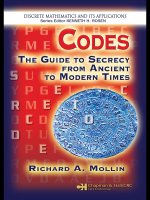Wiley level up the guide to great video game design 2010 RETAiL EBook
Bạn đang xem bản rút gọn của tài liệu. Xem và tải ngay bản đầy đủ của tài liệu tại đây (10.07 MB, 516 trang )
Copyright Information
Please note that the following characters are copyrighted to the following corporations:
Tennis for Two—This work is in the public domain in
the United States because it is a work of the United
States Federal Government under the terms of Title
17, Chapter 1, Section 105 of the US Code.
Space Invaders © 1978 Taito Corporation
Galaxian © 1979 Namco
Star Wars Arcade © 1983 Atari Inc.
PAC-MANTM & © 1980 NAMCO BANDAI Games Inc.
Space Panic © 1980 Universal
Popeye Arcade © 1982 Nintendo
Pitfall! and Pitfall Harry © 1982 Activision
Dark Castle © 1986 Silicon Beach Software
Donkey Kong and associated characters © 1981
Nintendo
Mario Bros. © 1983 Nintendo
Super Mario Bros., Mario, World 1-1, Super Mario
Bros. Theme © 1985 Nintendo
Ghost n’ Goblins © 1985 Capcom
Mega Man © 1987 Capcom
Mario 64 © 1996 Nintendo
Crash Bandicoot © 1996 Sony Computer
Entertainment
Wizard of Oz and associated characters © 1939
Metro-Goldwyn-Meyer
Monty Python and the Holy Grail and associated
characters © 1975
Star Wars and associated characters © 1977
Lucasfilm Ltd
Robocop © 1987–1998 Orion (MGM) Pictures
Maximo vs Army of Zin © 2004 Capcom
Maximo: Ghost to Glory © 2002 Capcom
Team Fortress 2 and associated characters © 2007
Valve Corporation
Laura Croft © 1996 Eidos Interactive
Batman © 2010 DC comics
Resident Evil 2 and associated characters © 1998
Capcom
Army of Two © 2008 Electronic Arts
Ico © 2001 Sony Computer Entertainment
Doom © 1993 id software
Darksiders © 2010 THQ
Syndicate © 1993 Electronic Arts
Supreme Commander © 2007 THQ
Warriors © 1979 Vectorbeam
Castle Wolfenstein © 1981 Muse Software
GoldenEye 007 © 1997 Nintendo
LittleBigPlanet © 2008 Sony Computer Entertainment
Europe
Playstation Dual Shock controller © 1998 Sony
Computer Entertainment
XBOX 360 controller © 2005 Microsoft
World of Warcraft © 2004 Blizzard Entertainment
Dragon’s Lair © 1983 Cinematronics
Bad Dudes vs Dragon Ninja © 1988 Data East
Mortal Kombat © 2009 Warner Brothers Interactive
Entertainment
Sleeping Beauty’s Castle, Haunted Mansion, Pirates
of the Caribbean, Peter Pan’s Flight and
associated characters, Pirate’s Lair © 2010 Walt
Disney Company
Prince of Persia © 2010 Ubisoft
Kratos © 2010 Sony Computer Entertainment of
America
Solid Snake © 1987 Konami
Marcus Fenix © 2006 Epic Games
Gauntlet © 1985 Atari Games
Spider-Man, Rhino © 2010 Marvel Entertainment/Walt
Disney Company
Bioshock and associated characters © 2007 2K
Games 2007
Demolition Man and associated characters © 1993
Warner Brothers
Earthworm Jim © 1994 Virgin Interactive
Master Chief © 2001 Microsoft Game Studios
Holst, the Planets—Mars Bringer of War, copyright
unknown
All other characters displayed within this book are created by Scott Rogers and cannot be
reproduced without his permission. © 2010 Scott Rogers
Dude with Sword, Dude with Sword 832, Relic
Raider, Farm Wars © 2010 Scott Rogers
The Mighty Bedbug, Grave Robber © 2005 Scott
Rogers
Dude with Sword © 2010 Scott Rogers
Dude with Sword 2 © 2010 Scott Rogers
Relic Raider © 2010 Scott Rogers
Die Zombie Die © 2010 Scott Rogers
Farm Wars © 2010 Scott Rogers
The Mighty Bedbug © 2005 Scott Rogers
Grave Robber © 2005 Scott Rogers
T
Leve I Up!
The Guide to Great Video
Game Design
Scott Rogers
A John Wiley & Sons, Ltd., Publication
This edition first published 2010
© 2010 John Wiley & Sons, Ltd
Registered office
John Wiley & Sons Ltd, The Atrium, Southern Gate, Chichester, West Sussex, PO19 8SQ, United Kingdom
For details of our global editorial offices, for customer services and for information about how to apply for
permission to reuse the copyright material in this book please see our website at www.wiley.com.
The right of the author to be identified as the author of this work has been asserted in accordance with the
Copyright, Designs and Patents Act 1988.
All rights reserved. No part of this publication may be reproduced, stored in a retrieval system, or transmitted,
in any form or by any means, electronic, mechanical, photocopying, recording or otherwise, except as
permitted by the UK Copyright, Designs and Patents Act 1988, without the prior permission of the publisher.
Wiley also publishes its books in a variety of electronic formats. Some content that appears in print may not
be available in electronic books.
Designations used by companies to distinguish their products are often claimed as trademarks. All brand
names and product names used in this book are trade names, service marks, trademarks or registered
trademarks of their respective owners. The publisher is not associated with any product or vendor mentioned
in this book. This publication is designed to provide accurate and authoritative information in regard to the
subject matter covered. It is sold on the understanding that the publisher is not engaged in rendering
professional services. If professional advice or other expert assistance is required, the services of a
competent professional should be sought.
Refer to page ii for further copyright information pertaining to the content of this book.
ISBN 978-0-470-68867-0
A catalogue record for this book is available from the British Library.
Set in 10 on 12pt Swiss721BT-Light by Toppan Best-set Premedia Limited
Printed in the US by RR Donnelley
To Brenda Lee
who always thought this would make a great book.
I love you.
Publisher’s Acknowledgments
Some of the people who helped bring this book to market include the
following:
Editorial and Production
VP Consumer and Technology Publishing Director: Michelle Leete
Associate Director—Book Content Management: Martin Tribe
Associate Publisher: Chris Webb
Assistant Editor: Colleen Goldring
Publishing Assistant: Ellie Scott
Project Editor: Juliet Booker
Content Editor: Céline Durand-Watts
Development/Copy Editor: Gareth Haman
Technical Editor: Noah Stein
Marketing
Senior Marketing Manager: Louise Breinholt
Marketing Executive: Kate Batchelor
Composition Services
Compositor: Toppan Best-set Premedia Limited (HK)
Proof Readers: Sarah Lewis and Gill Whitley
Indexer: Robert Swanson
Contents
Foreword by Danny Bilson
About the Author
Press Start!
Acknowledgments: Everything I Learned about Writing a Book
xiii
xiv
xv
xxi
Level 1
1
4
9
12
12
13
14
15
16
17
18
19
19
20
20
21
21
21
22
Welcome, N00bs!
A Brief History of Video Games
Game Genres
Who Makes this Stuff?
Programmer
Artist
Designer
Producer
Tester
Composer
Sound Designer
Writer
Have You Thought about Publishing?
Product Manager
Creative Manager
Art Director
Technical Director
And the Rest . . .
Level 1’s Universal Truths and Clever Ideas
viii
Contents
Level 2 Ideas
Ideas: Where to Get Them and Where to Stick Them
What do Gamers Want?
Why I Hate “Fun”
Brainstorming
Breaking Writer’s Block
Level 2’s Universal Truths and Clever Ideas
23
24
28
30
31
34
36
Level 3 Writing the Story
The Triangle of Weirdness
Time to Wrap It Up
Creating Characters
A Few Pointers on Writing for Kids of All Ages
Writing for Licenses
Level 3’s Universal Truths and Clever Ideas
37
44
48
50
54
54
56
Level 4
You Can Design a Game, But Can You Do the Paperwork?
Writing the GDD, Step 1: The One-Sheet
ESRB Ratings
Writing the GDD, Step 2: The Ten-Pager
The Rule of Threes
Ten-Pager Outline
The Game Design Document (and the Awful Truth about Writing Them)
Gameplay Progression
The Beat Chart
Above All, Don’t Be a Schmuck
Level 4’s Universal Truths and Clever Ideas
57
60
60
62
63
64
72
76
77
79
81
Level 5
The Three Cs, Part 1—Character
Personality: Do We Really Need Another Badass?
Let’s Get Personal
Finally, We Talk about Gameplay
Why Walk When You Can Run?
The Art of Doing Nothing
Might as Well Jump
Hoists and Teeters
What Goes Up, Must Fall Down
Me and My Shadow
83
85
88
92
95
99
100
104
105
106
Contents
Level 6
Level 7
ix
The Water’s Fine… or Is It?
Be Kind to Our Four-Legged Friends
Using All of the Parts
We Are Not Alone
Who Are the People in Your Neighborhood?
Level 5’s Universal Truths and Clever Ideas
108
109
110
111
116
118
The Three Cs, Part 2—Camera
Get It Right: Camera Views
First Person Camera
Third Person Camera
Giving Up Control
So You’ve Decided to Let the Player Control the Camera
So You’ve Decided to Not Let the Player Have Control Over
the Camera
So You’ve Decided to Let the Player Sometimes Have Control
Over the Camera
Two and a Half D
Isometric Camera
Top-Down Camera
Special Case Cameras
Tunnel Vision
Camera Shot Guide
Camera Angle Guide
Camera Movement Guide
Other Camera Notes
Always Point the Camera to the Objective
Never Let the Character Get Out of the Camera’s Sight
Multiple Player Cameras
Level 6’s Universal Truths and Clever Ideas
121
121
127
130
133
133
The Three Cs, Part 3—Controls
Dance, Monkey, Dance
Character or Camera Relative?
Shake, Rattle and Roll
Level 7’s Universal Truths and Clever Ideas
155
159
164
166
168
135
137
137
138
139
140
141
141
145
146
148
149
150
151
153
x
Contents
Level 8 Sign Language—HUD and Icon Design
Health Bar
Targeting
Ammo Gauge
Inventory
Score
Radar/Map
Context-Sensitive Prompt
The Clean Screen
Icon Has Cheezburger?
Don’t Get QTE
HUDs, and Where to Stick ‘Em
There Are Other Screens Than the HUD
The Pause that Refreshes
A Final Word on Fonts
Level 8’s Universal Truths and Clever Ideas
171
172
173
174
174
175
176
177
178
179
183
185
187
189
195
196
Level 9 Everything I Learned about Level Design, I Learned from Level 9 197
The Top 10 Cliché Video Game Themes
200
The Name Game
207
Everything I Learned about Level Design, I Learned from Disneyland
208
The Beat Chart
214
Re-using Re-use
216
The Gary Gygax Memorial Mapping Section
217
The Dave Arnenson Memorial Mapping Section
223
Wrapping Up Mapping
229
Illusional Narrative
232
Gray Matters
233
Leave the Training Level for Last
239
Level 9’s Universal Truths and Clever Ideas
240
Level 10 The Elements of Combat
400 Quatloos on the Newcomer!
Now You have to Kiss Me
On Moving
On Guarding
State of the Art Bang Bang
243
245
254
255
258
261
Contents
The Best Gun for You
Run and Gun
Not Just Shooting
Dammit Jones, Where Doesn’t It Hurt?
Death: What is It Good For?
Level 10’s Universal Truths and Clever Ideas
xi
265
269
271
275
277
279
Level 11 They All Want You Dead
Bring on the Bad Guys
I Love Designing Enemies
I Hate You to Pieces
Non-Enemy Enemies
How to Create the World’s Greatest Boss Battle
Who’s the Boss?
Size Matters
Location, Location, Location
Why Not to Create the World’s Greatest Boss Battle
Level 11’s Universal Truths and Clever Ideas
281
294
304
314
317
318
319
321
326
327
329
Level 12 The Nuts and Bolts of Mechanics
Holy Death Trap!
Time to Die
The Music of Mechanics
A Nice Little Calm Spot
Riddle Me This
A Short Word on Minigames and Microgames
Level 12’s Universal Truths and Clever Ideas
331
335
339
341
345
346
351
353
Level 13 Now You’re Playing with Power
“Love Thy Player”
More Wealth Than You Can Imagine!
Level 13’s Universal Truths and Clever Ideas
355
361
365
378
Level 14 Multiplayer—the More the Merrier
How Many is the Right Number?
MMORPGS, or Hell is Other People
Level 14’s Universal Truths and Clever Ideas
381
385
386
391
xii
Contents
Level 15 Some Notes on Music
Sounds Like a Game to Me
Level 15’s Universal Truths and Clever Ideas
393
400
404
Level 16 Cutscenes, or No One’s Gonna Watch ‘Em Anyway
How to Write a Screenplay in Eight Easy Steps
Level 16’s Universal Truths and Clever Ideas
407
410
416
Level 17 And Now the Hard Part
No One Cares about Your Stupid Little World
Video Games is a Haaaard Business
What to Do for an Encore?
Level 17’s Universal Truths and Clever Ideas
417
418
421
425
427
Continue?
Bonus Level 1: The One-Sheet Sample
Bonus Level 2: The Ten-Page Design Document Sample
Bonus Level 3: Game Design Document Template
Bonus Level 4: The Medium-Sized List of Story Themes
Bonus Level 5: The Big List of Environments
Bonus Level 6: Mechanics and Hazards
Bonus Level 7: Enemy Design Template
Bonus Level 8: Boss Design Template
Bonus Level 9: High Concept Pitch Presentation
Achievement Unlocked: Exactly Like Making Chili
Index
429
431
435
445
459
461
465
467
469
471
481
483
Foreword
Scott set out to write a handbook; a general text that any designer can pull
off their shelf or call up on their PC or e-reader when they want to get back
to fundamentals. A sort of Scout Handbook or Farmer’s Almanac for game
creation. Scott has even included the kind of clear and simple illustrations
you might find in these evergreen texts.
When any team in sports, any military unit, or any human endeavor wants
success, they start in one place: with the basics. How many times have we
heard after a big win, “It’s all about fundamentals.” One of those
fundamentals I’ve found valuable in game design is the concept of “doing
one thing, well.” Well, Mr. Rogers has done just that with his handbook.
Whether you are starting out as a new designer or are a veteran who’s stuck
on a difficult problem, pull this handbook off the shelf, get back to the
fundamentals, and I’ll bet they trigger some inspiration that will take you
beyond.
Danny Bilson
Executive Vice President of Core Games, THQ
February 2010
About the Author
After discovering that game designers have more fun, Scott Rogers
embarked on a 16-year-(and counting) career in video games. He has
helped design many successful video games including: Pac-Man World, the
Maximo series, God of War, Drawn to Life series and Darksiders. Scott is
currently a creative manager for THQ and lives just outside nuclear strike
range of Los Angeles with his lovely wife, two children and many, many
action figures.
Press Start!
If You Are Anything Like Me…
… then you’ll read the first page of a book before you buy it. I find that if I
like the first page, then I’ll probably like the whole thing. I have noticed that
many books have an exciting excerpt on the first page in order to grab the
reader’s interest, such as:
The zombie’s filthy claws clutched hungrily at Jack’s shirt, even as his blade
split the creature’s head like a ripe melon. A firm kick to its headless torso
sent it sprawling down the stairs into the greedy mob that surged forward
like a wave. The corpse’s undead brothers and sisters paused their onslaught
until they realized the decapitated body was just dead meat. Their hesitation
gave Jack a second to spare a glance over his shoulder and see that Evelyn
had finally reached the helicopter. Jack braced himself for the oncoming mob.
“Get that thing started! I can’t hold them off forever!” he yelled, as he severed
several greedily clutching hands from their wrists. “But, Jack!” Evelyn screamed
back, frantically flipping switches. “I don’t know HOW to fly a helicopter!”
Not that I would ever resort to such cheap tactics in this book. I have also
noticed that some books try to gain respectability by publishing a positive
quote from an industry professional or famous person on their first page:
I learned more from reading the first page of Level Up! The Book of Great Video
Game Design than I learned in working for 25 years in the video game industry!
A very famous game designer1
1
No doubt you are smart enough to have realized that this isn’t a real quote, because there
isn’t a very famous game designer. Unless you count Shigeru Miyamoto, the creator of Mario.
Drat! I should have translated the above quote into Japanese!
xvi
Press Start!
You obviously don’t need someone else to tell you how to make up your
mind. Just by picking up this book, I can tell you are a discriminating
reader. I can also tell you are seeking the straight truth on the creation of
video games. This book will teach you the who, what, where and, most
importantly, how to design video games. If you have an interest in arcade
games, boss fights, chili, deadly traps, ergonomics, fun, giant hydras,
haunted mansions, islands and alleys, jumps, killer bunnies, leitmotifs,
Mexican pizza, non-player characters, one-sheet designs, pitch sessions,
quests, robotic chickens, smart bombs, the triangle of weirdness, un-fun,
violence, whack-a-mole, XXX, Y-axis and zombies, then this is the book
for you.
Before we start, keep in mind that there are many ways to approach game
design. All of them are valid, as long as they can communicate the
designer’s ideas. The tricks and techniques found in Level Up! are MY
WAYS of creating game design.
Another quick reminder, when I say “I designed a game” this is an
oversimplification. Video games are created by many, many, many talented
people (you’ll be introduced to them shortly) and to give the impression that
I did all the work myself is not only incorrect but egotistical2. There is no “I”
in team3.
The majority of the games I’ve helped design were single player action
games, so many of the examples found in Level Up! will be skewed towards
that perspective. It’s just the way I think. But I have also found that most of
the gameplay concepts are transferable to many different genres of games.
It won’t be too hard for you to translate my advice to your own game, no
matter what the genre.
Another thing before we get started. If you are looking for a single chapter
about gameplay, don’t bother. Because EVERY chapter in this book is about
gameplay. You should be thinking about gameplay all the time and how
things affect the player, even when designing passive elements like
cutscenes and pause screens.
Since you have made it this far, I may as well start by actually telling you
the bad news first. Making video games is very hard work4. I have worked
in video games for over 16 years and on games that have sold millions of
copies.
2
It’s a small industry. No one can afford to piss anyone off! Be a nice, hardworking person
and you’ll go far.
3
Ironically, there is a “me.”
4
I once hadan employer who would walk the halls of our office muttering how “video games
are a haaaard business.” I used to laugh at him back then, but I don’t any more. He was
right.
Press Start!
xvii
But in that time, I have learned that making video games is also the best job
in the world. It can be thrilling, frustrating, rewarding, nerve-wracking, hectic,
boring, vomit-inducing, and just plain fun.
No, You Can’t Have My Job
Over the course of my career, I came up with some Clever Ideas and
learned some Universal Truths. For your convenience, I have added these
at the end of each “level.”
I also learned a couple of very important things. You can tell they are
very important because they are written in all bold letters. The first very
important thing I learned was:
GAME DESIGNERS HAVE MORE FUN
I know this, because my first job in the video game industry was as an
artist5. Back in those 16-bit days, video game artists drew images with
pixels. There are several great 16-bit artists, like Paul Robertson and the
teams that made the Metal Slug and classic Capcom fighting games; but
for me, drawing pictures out of pixels is like drawing with bathroom tiles.
Here is what a drawing I made out of pixels looks like:
Anyway, as I was “pushing pixels” I heard the sound of raucous laughter
coming from the group of cubicles next to mine. I peered over the wall to
see a bunch of video game designers yukking it up and have a good ol’
time. For the record, I was not having a good ol’ time pushing pixels. I
realized, “Those game designers are having more fun than I am! Making
5
Actually we were called “pixel pushers” and “sprite monkeys”, neither of which, despite how
cute those terms sound, were ever meant as a compliment.
xviii
Press Start!
video games should be fun! I want to have fun! I want to become a game
designer too!” And so I did. I eventually worked my way up the ladder to
become a game designer. After I became a real game designer, I learned
the second very important thing:
NO ONE ON YOUR TEAM WANTS TO READ YOUR DESIGN
This is a horrible thing to discover, but it is something every game designer
needs to hear. Here I was, a brand new game designer with brand new
game designs ready to go, and no one wanted to read any of them! What
was I to do? In order to solve this problem and get my colleagues to read
my design documents, I started drawing them as cartoons. And guess
what? It worked. They conveyed the ideas I wanted to get across to my
team mates. And I’ve been designing games this way ever since, many of
which have gone on to become top-selling titles. That is why you will find
many cartoons, so you will continue reading and understand the ideas
presented. If you do, then you can apply them to your own design and
become a great designer, too.
Press Start!
xix
Who Is This Book For?
Why you, of course. Provided you are one of the following people.
A working video games professional. There are lots of books about
video games design, but most of them are full of THEORY, which I have
never found very helpful while making a game. Don’t get me wrong, theory
is great when you are at a game developers conference or one of those
wine and cheese affairs we game designers always find ourselves at. But
when I am working on a game, with my sleeves rolled up and blood
splattered all over the walls6, I need practical nuts n’ bolts advice on how
to solve any problems I may encounter. I mention this because I assume
that some of you reading Level Up! will be experienced video game
professionals. I hope you find the techniques and tips in this book useful in
your day-to-day work. Not that this book doesn’t have uses for beginners.
I’m talking about you, future video game designers. Remember, one
page ago when I told you I was a pixel pusher? There was a point to that
story, which is I was just like you. Maybe you’re also an artist who is tired of
hearing the game designers laughing it up over in the other office. Or a
programmer who knows he can design a better enemy encounter than the
knucklehead currently doing it on your game. Or maybe you are a tester
who wants to move up in the world, but you don’t know how to do it. When I
wanted to become a video game designer, there weren’t any books on the
subject. We had to learn everything from other game designers. I was lucky
to have a mentor and an opportunity to work as a game designer. If you
don’t have either of these things, don’t fret. Read this book; I will be your
mentor. All you need to do is follow my advice, be prepared, and take
advantage of the opportunity when it finally arrives.
This book is also great for students of video game design. Back when I
started making games, I didn’t take any classes on video game design—
because they didn’t exist! I just made stuff up as I went along! And I made
a lot of mistakes. This is why I wrote this book: so you can learn from all my
mistakes before they become your mistakes too.
Finally, this book is for anyone who loves video games. I love video
games. I love to play them. I love to make them and I love to read about
making them. If you want to make video games, then you must love them
too. Ironically, I know several people who work in video games that freely
admit they do not like to play video games. That does not make any sense
6
Figurative blood. To my knowledge, no one has died from making a video game.
xx
Press Start!
to me. Why would you work in video games if you do not love video games?
They are fools. They should just step aside and let someone who loves
video games make video games. Someone like you.
Ready? Great! Let’s find out how to make games!
Acknowledgments:
Everything I Learned About
Writing A Book
I hope you found Level Up! The Guide to Great Video Game Design to be
educational and inspirational. What I’ve learned is that books don’t write
themselves and writers can’t write without support and inspiration from lots
of great people. I couldn’t have written Level Up! The Guide to Great Video
Game Design without the love, help, and support of the following family and
friends:
Brenda Lee Rogers, Evelyn Rogers, Jack Rogers, Noah Stein, Hardy LeBel,
Dr. Brett Rogers, Jackie Kashian, Danny Bilson, Laddie Ervin, Tim Campbell,
THQ games legal department, Jeremiah Slackza (for requesting the Platform
Primer), mentors William Anderson and David Siller, Mark Rogers, Eric
Williams, George Collins, Scott Frazier (my first test audience), Andy
Ashcraft, Paul Guirao, Tommy Tallarico, Joey Kuras, Ian Sedensky, Evan
Icenbice, Brian Kaiser, Jason Weezner, David O’Connor, Jaclyn Rogers, Dr.
Christopher Rogers, Patricia Rogers, Anthony Rogers, The GDC selection
committee of 2008, Disneyland’s original imagineers, the Los Angeles
customizing gang, the editors at John Wiley & Sons, Ltd: Juliet Booker,
Gareth Haman, Katherine Batchelor, Ellie Scott, and most importantly, Chris
Webb for making that call. And special thanks to Cory Doctrow for the
glowing GDC review that kicked all of this off. I owe you a drink, mate.
And a big thank you to YOU for buying this book. Now go and design some
great games! I can’t wait to play them!
T
LeveI 1
Welcome, N00bs!
This chapter is written especially for people who are new to video games
and how they are made. If you are not a n00b1, then feel free to skip it.
However you are going to be missing out on a lot of great stuff. Don’t say
I didn’t warn you.
Within the academic gaming community, there are many different
definitions for what qualifies as a game. Some scholars insist that “a
game needs to be a closed formal system that subjectively represents
a subset of reality2.” Others say that games need to have “players in
conflict with each other3.” I think those definitions are trying too hard to
sound smart.
Games, while complex, are often simpler than that. Bernard Suits4 wrote
that “playing a game is a voluntary effort to overcome unnecessary
obstacles.” This is a pretty amusing definition, but still a bit too scholarly
for my taste. Let’s keep things simple. Let’s consider hand ball. You only
need one player for hand ball—where’s the other players to be in conflict
with? Bouncing a ball against a wall without missing it is hardly a
metaphor for reality; unless you lead a very boring life. Let’s face it,
sometimes a ball bouncing against a wall is just a ball bouncing against
a wall.
1
A n00b is short for “newbie”, or someone who is new to a game. While the term predates
the Internet, it became popular with MO communities. Not a particularly flattering term, as
it implies inexperience and/or ignorance: only a real n00b would read a footnote defining
what a n00b is!
2
“What is a Game?”, Chris Crawford in The Art of Computer Game Design, 1982.
3
“What is a Game?”, Kevin Langdon in The New Thesaurus, 1979.
4
The Grasshopper: Games, Life and Utopia, Bernard Suits, 1978.









